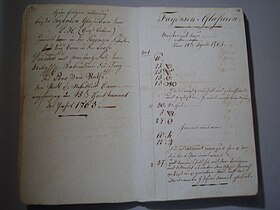Daniel Herrmann

Daniel Herrmann (* 1736 ; † 1798 ) was a potter from Langnau in the Emmental and between 1762 and 1776, after the departure of Johann Adam Spengler , the second manager of the Frisching faience factory in Bern .
During this time he wrote about 70 color and glaze recipes, including over 24 different ones for faience glazes. The recipes for engobes , glazes and paints were professional secrets of the individual stoners.
In 1774 Daniel Herrmann acquired the property at Höheweg 1 in Langnau, where he and his descendants produced Langnau ceramics for four generations . Your workshop delivered the highest quality products, including a. the so-called "wedding bowls", d. H. Ceramic show dinners decorated with fruit and vegetables . Tiled stoves were also produced.
The recipe book by Daniel Herrmann
Daniel Herrmann's recipe book with entries from 1763 to 1776 has been handed down as a copy from 1861 by his grandson of the same name , who was in Langnau Hafner. It also contains glaze recipes for oven tiles from 1823 to 1830 and notes from around 1841–1861.
Daniel Herrmann introduced his recipe book with the following words: "Here are all the white faience glazes from DH back then in the faience factory near Bern in the Loohr ( Lorraine ). Director and master craftsman of the faience factory in Mwghh. Brothers Frisching of the Great Council of the city and republic Bern started on the 15th autumn month of the year 1763 ".
The first entries up to 1765 include recipes for faience glazes. Herrmann, who, as a Langnauer Hafner, had above all experience with engobes and lead glazes , had to acquire the specialist knowledge for the production of high-quality faience largely himself. The glaze recipes are followed by instructions for preparing the paint colors green, yellow-green, blue, black and purple to paint floral motifs and Japanese ornaments. On January 7, 1766 , Herrmann noted purple as the first onglaze color , consisting of separating water , salmiak , gold and tin . Daniel Herrmann perhaps owed his knowledge of these color mixtures to the painter Johann Franz Adam Hess . Hess was born in Fulda in 1741 as the son of a painter who worked in the porcelain and faience factory Höchst . He worked in the Bernese faience manufactory Frisching since 1765 and certainly brought with him specialist knowledge from the Hessian manufactory , which had existed since 1746.
In Switzerland , in addition to Herrmann's recipe book, two recipe books by the Winterthur stoner David II. Pfau from 1725 and the recipe books by Peter and Christian Lötscher from St. Antönien in Graubünden from around 1800 and 1837 are known (largely unpublished to date) . The interest of the enlightened sciences meant that the recipes, which were once kept secret, were published, for example in the Encyclopédie by Denis Diderot and Jean-Baptiste le Rond d'Alembert , which was revised and published in Bern and Lausanne in 1780/81 .
literature
- Wolf Matthes: The recipe booklet from Hafner Herrmann from Langnau - A contribution to the technique of historical faience glazes and colors of the 18th century. In: Andreas Heege / Andreas Kistler, ceramics from Langnau, on the history of the most important land farming in the canton of Bern ( writings of the Bernische Historisches Museum 13.1), Bern 2017, 226–238.
- Walter A. Staehelin: Ceramic research from Bernese archives. In: Ceramic Friends of Switzerland. Newsletter. No. 81, 1970, ISSN 0023-0553 , pp. 3-34.
- Robert L. Wyss: The stoner Salomon Landolt in Neuenstadt. In: Peter Meyer (Ed.): Illustrated Bern Encyclopedia. Volume 4: Art and Culture in the Canton of Bern. Büchler, Wabern-Bern 1987, ISBN 3-7170-187-6 , pp. 107-109.
- Adriano Boschetti-Maradi: tableware for town and country. Bern pottery since the 16th century (= highlights from the Bern Historical Museum. 19). With photographs by Yvonne Hurni. Chronos-Verlag, Zurich 2007, ISBN 3-03-400864-3 .
- Adriano Boschetti-Maradi: The tiled stove - a necessity and a showpiece. In: André Holenstein (Ed.): Bern's golden time. Rediscovered in the 18th century (= Bern times. 4). Stämpfli Verlag AG, Bern 2008, ISBN 978-3-7272-1281-9 , p. 112.
Individual evidence
| personal data | |
|---|---|
| SURNAME | Herrmann, Daniel |
| BRIEF DESCRIPTION | Swiss stove |
| DATE OF BIRTH | 1736 |
| DATE OF DEATH | 1798 |